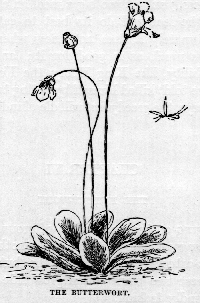
THE BUTTERWORT
Growing on the same patch of ground as the sundew we may sometimes find another little insect-catching plant, called the butterwort, for these two plants often grow side by side in friendly fashion.
The butterwort is easily distinguished from its sometime neighbor, the sundew, by its plump, glistening, yellowish-green leaves, which are supposed to resemble little pats of butter, and from this the plant has gained its common name. But, of course, the butterwort, like all other plants, has another long-and learned name by which it is known to learned botanists, and this name is really a very funny one, translated into plain English, it simply means "the little fat one."
The plump little leaves from which this little marsh-land plant has gained its very quaint name lie flat on the damp ground, arranged in a rosette, and in May, June and July from the center of the rosette rise slender flower-stalks three or four inches long, each one bearing a beautiful violet-colored flower. Really the butterwort looks such a charming little plant that one would never suspect it of being a plant ogre.
But those plump, buttery-looking leaves, which rest upon the ground with their faces upturned to the sky, are just as deadly to the little insect folk as the leaves of the greedy sundew, for they capture and devour every small fly, midge, beetle, moth or ant that settles on them.
In shape the leaves are oval, and the edges curve slightly upwards, turning every leaf into a shallow trough, like the bowl of a spoon. The inside of the bowl is covered with a thick, treacly fluid poured forth from quantities of tiny glands scattered all over the upper surface. The glands are of two kinds: some are flat cells or pockets, and some are like tiny mushrooms in shape, but we can only see this if we examine a piece of a leaf under the microscope. On every leaf there are thousands of these glands, and on a single rosette of six leaves or so there must be something like half a million of them.
When rain-drops patter on the leaves, or grains of sand or earth are blown upon them, they take no notice, but directly an insect alights upon a leaf it at once becomes excited, and an extra supply of sticky liquid oozes from the glands. But this is not all that happens. The edges of the leaf begin to curl over, trying to cover the insect, or push it into the middle of the spoon and drown it in the fluid. The leaf does not curl up very quickly, not nearly fast enough to catch a struggling insect; but this is not necessary, as the little creature is glued fast to the leaf, and its struggles to free itself only cause it to sink more deeply into the thick stream poured forth from the thousands of tiny glands.
If the insect is a large one and the leaf is very much excited, its bowl-shaped blade becomes quite full of the sticky stuff, and the poor victim is speedily suffocated. Then slowly and surely the edges of the leaf continue to curl over, and in an hour or two the leaf is quite closed up and the insect is hidden from view. The leaf remains shut up for about twenty-four hours, and then slowly uncurls again. And all that is left of that insect is the wings, the claws, the skin and the indigestible parts of its skeleton.
Although the butterwort will have nothing to do with such useless things as sand, coal dust, paper and so forth, it likes vegetable, as well as animal food, and when little bits of other plants, pollen, and spores fall upon its leaves they are speedily dissolved and digested in the fluid.
The juice from the leaves of the " little fat one" is very acid and contains the same properties as rennet. with which you know warm milk is turned into curd or junket. This was discovered and turned to account by the people of Lapland ever so many years ago, and one of their favorite sour-milk dishes was made by pouring fresh warm milk over the leaves picked from the little butter wort. Hundreds of years ago, too, the shepherds in the Alps used to gather the leaves of this little plant and use them to cure sores on their cattle. Whether they actually cured them I should hardly like to say, but the cool damp leaves would at least keep flies from the sore places and in this way they would certainly do good. So this little plant-ogre has proved useful in many ways.